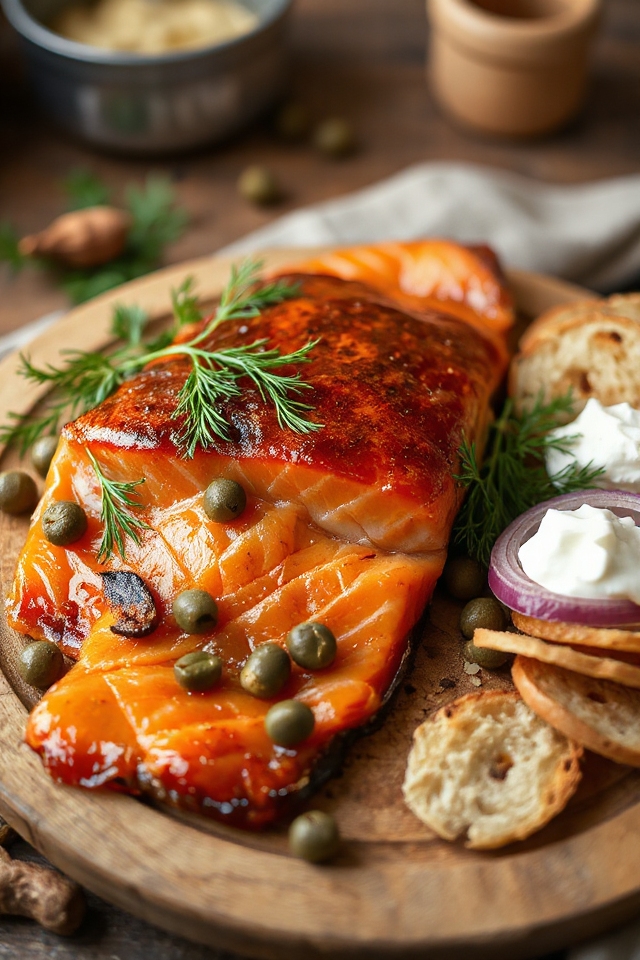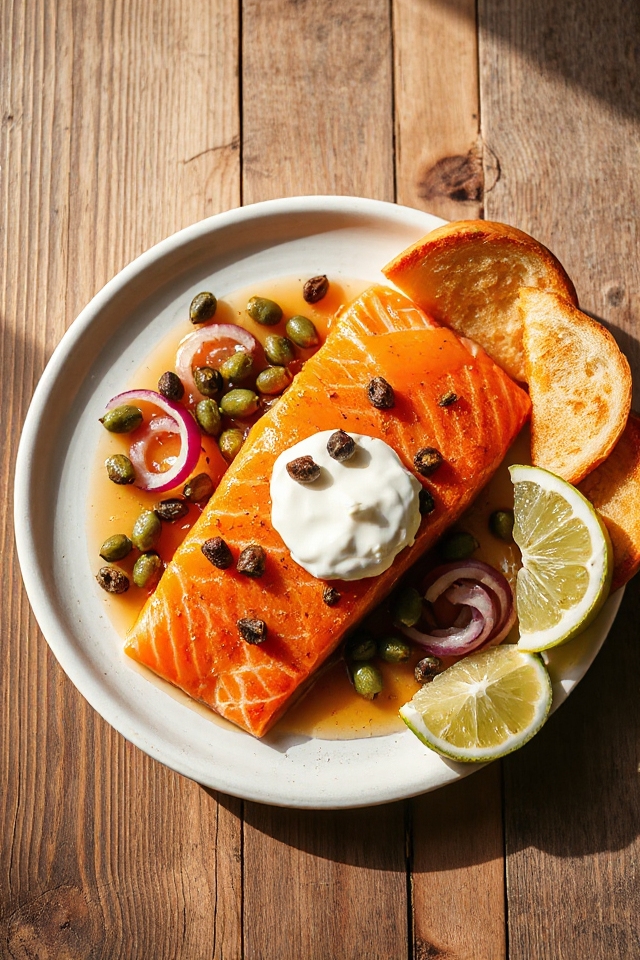Why You’ll Love This Smoked Salmon Recipe
If you’ve ever tasted homemade smoked salmon, you know why this recipe is a must-try. The rich, smoky flavor and tender texture set it apart from store-bought versions.
I love how this recipe allows me to customize the seasoning, giving me the freedom to experiment with different spices. It’s surprisingly simple too; with just a bit of patience, I can create something truly gourmet at home.
Plus, it’s perfect for gatherings, impressing friends and family alike. Each bite brings a delightful balance of sweet and savory that keeps them coming back for more.
Trust me; you won’t regret trying this!
Ingredients of Smoked Salmon
When it comes to making smoked salmon, the right ingredients are essential to achieving that perfect balance of flavors. This recipe calls for a delightful mix of sweet and savory elements, which come together to create a truly gourmet dish. You’ll find that most of these ingredients are easily accessible, and if you’re like me, you might already have some of them tucked away in your pantry.
So, let’s explore what you’ll need to gather before you fire up the grill.
Ingredients for Smoked Salmon
- 1 cup brown sugar, packed
- 6 tablespoons salt
- 1 tablespoon fresh ginger, chopped
- 2 bay leaves
- 1 teaspoon whole allspice, crushed
- 3 lbs salmon fillets
- 1/2 cup mixed peppercorns
- 1/2 cup hickory chips
- 1 tablespoon honey
- 1 1/2 cups water
Now, let’s chat about some of these ingredients. For starters, if you’re not a fan of brown sugar, you could experiment with other sweeteners, but the brown sugar really adds that rich, caramel-like flavor which works wonders when combined with the smokiness.
Fresh ginger gives a lovely zing to the brine, so don’t skimp on it. And can we talk about the salmon? If you can get your hands on wild-caught salmon, I say go for it; the flavor is just out of this world compared to farmed.
Finally, the hickory chips are what brings that signature smoky taste. If you’re feeling adventurous, try mixing in some apple or cherry wood chips for a different twist.
The beauty of this recipe is that it’s flexible, allowing you to make adjustments based on what you have on hand or what you prefer. So, don’t be afraid to get creative.
How to Make Smoked Salmon

Alright, let’s explore the delicious world of smoked salmon. First up, you’ll want to prepare your brine. Grab a 1-quart pan and combine 1 1/2 cups of water with 1 cup of packed brown sugar, 6 tablespoons of salt, 1 tablespoon of chopped fresh ginger, 2 bay leaves, and 1 teaspoon of crushed whole allspice.
Bring that mixture to a boil over high heat, stirring until the sugar dissolves completely. This sweet and savory concoction is what’s going to infuse the salmon with tons of flavor. Once it’s boiling and your kitchen smells like a sweet little heaven, let it cool slightly.
While your brine is chilling out, rinse your 3 lbs of salmon fillets under cool water and pat them dry with a paper towel. Place the fillets skin side down in a rimmed pan—something around 12×15 inches works perfectly.
Pour that cooled brine over the salmon, making sure it’s all coated, and cover the pan tightly. Now, here’s the hard part: you need to chill that fish in the refrigerator for at least 4 hours, but if you can wait up to 24 hours, it’ll be even better. Trust me, the anticipation is worth it. Just remember to occasionally spoon that brine over the salmon for even more flavor love.
Once you’re ready to smoke, it’s time to fire up the grill. Get about 16 charcoal briquettes going and place them on the fire grate. While those are igniting, soak your 1/2 cup of hickory chips in water and your 1/2 cup of mixed peppercorns in hot water for at least 15 minutes.
After the coals are dotted with gray ash, push them to the sides of the grill and drain your wood chips, scattering them over the briquettes. Place your salmon skin side down on a large piece of foil, and rub 1 tablespoon of honey over the top. Scatter those drained peppercorns on the salmon, patting them lightly to stick.
Now you’re ready to grill it up. Set your grill 4 to 6 inches above the coals, place the salmon in the center (no coals underneath!), and cover it up with the lid. Keep an eye on the temperature; you want it to stay around 160 degrees F. If it dips, open the vents a bit; if it goes too high, close them down.
Add 3 briquettes every 30 minutes and keep that smoke rolling with more wood chips as needed. The salmon is done when the thickest part reaches 140 degrees, which should take about 1.5 hours.
Once it’s ready, use that foil to slide the fillet onto a baking sheet and transfer it to a platter. You can serve it warm, cool, or chilled, and if you’re feeling fancy, slice it across the grain into 3/4-inch pieces.
Pair it with capers, minced red onion, sour cream, thin toast, and lime wedges for a delightful touch. Now, wasn’t that a journey? Who knew making smoked salmon could be such an adventure in your own backyard?
Smoked Salmon Substitutions & Variations
Ever wondered how to switch things up with smoked salmon? I love experimenting with different flavors and ingredients.
You can try using trout or mackerel as a substitute; they both smoke beautifully. If you’re looking for a vegetarian option, consider using smoked eggplant or tofu for a similar texture.
For a twist, add spices like dill, lemon zest, or even a touch of sriracha to your brine. You might also want to experiment with different woods for smoking, like apple or cherry, to impart unique flavors.
These variations keep my smoked salmon exciting and fresh every time!
Additional Tips & Notes
Experimenting with substitutions and variations can really elevate your smoked salmon experience. Don’t hesitate to play with spices or herbs—like dill or lemon zest—to personalize your flavor.
If you’re short on time, consider cold smoking for a quicker method. Also, remember that the quality of salmon matters; fresh, wild-caught options usually yield the best results.
When serving, pair with a variety of accompaniments, such as pickled vegetables or artisanal breads, to enhance the meal.
Finally, enjoy leftovers in salads or on bagels; the flavor only gets better! Trust me, these little tweaks can make a big difference.
